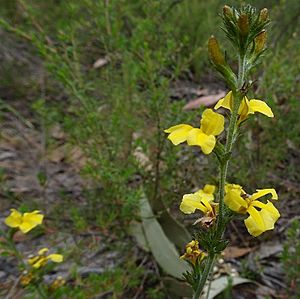Daisy goodenia facts for kids
Quick facts for kids Daisy goodenia |
|
|---|---|
 |
|
| Goodenia bellidifolia subsp. bellidifolia in southern New South Wales | |
| Scientific classification | |
| Genus: |
Goodenia
|
| Species: |
bellidifolia
|
| Synonyms | |
|
|
The Goodenia bellidifolia, also known as daisy goodenia, is a beautiful flowering plant. It belongs to the Goodeniaceae family. This plant is special because it is endemic to eastern Australia. This means it grows naturally only in that part of the world.
Daisy goodenia is a plant that stands tall. It is a perennial herb, which means it lives for more than two years and has soft, green stems instead of woody ones. It has leaves shaped like an egg or a spear. Its flowers are a lovely lemon-yellow to orange color. After flowering, it produces small, round fruits.
What Daisy Goodenia Looks Like
Daisy goodenia is a plant that usually grows up to 60 cm (24 in) tall. Its stems can be smooth or have a soft, cotton-like fuzz.
The leaves of the daisy goodenia are quite interesting. They are shaped like an egg or a spear, being wider at the top and narrower at the bottom. These leaves can be 40–100 mm (1.6–3.9 in) long and 5–20 mm (0.20–0.79 in) wide. Sometimes, their edges have small, uneven teeth.
The flowers grow in tall clusters, sometimes up to 400 mm (16 in) long. Each flower might have a tiny stem, about 3 mm (0.12 in) long. At the base of the flowers, there are small, thin leaves called bracteoles, also about 3 mm (0.12 in) long.
The flower itself has small, linear sepals, which are like tiny leaves protecting the bud. These are 1.5–4 mm (0.059–0.157 in) long. The petals, known as the corolla, are lemon-yellow to orange. They can have fuzzy hairs on the outside and grow up to 12 mm (0.47 in) long. The bottom parts of the petals have small flaps, or "wings," about 1–1.5 mm (0.039–0.059 in) wide.
Daisy goodenia flowers bloom from August to March. After the flowers fade, they turn into small, oval or round fruits. These fruits are called capsules and are about 4 mm (0.16 in) long.
How Daisy Goodenia Got Its Name
The daisy goodenia was first officially described in 1794. This was done by a scientist named James Edward Smith. He wrote about it in a publication called Transactions of the Linnean Society of London.
Later, in 1981, two other scientists, Surrey Wilfrid Laurance Jacobs and J. Pickard, looked closer at the daisy goodenia. They found two slightly different types, or subspecies. One was called Goodenia bellidifolia subsp. A, and the other kept the original name, Goodenia bellidifolia subsp. bellidifolia.
In 1990, another scientist, Roger Charles Carolin, officially named subspecies A as Goodenia bellidifolia subsp. argentea. Both of these subspecies are now recognized in the Australian Plant Census, which is an official list of Australian plants.
Here's how you can tell them apart:
- Goodenia bellidifolia subsp. argentea usually has lemon-yellow petals. These petals have soft, white, cotton-like hairs on their backs. Its fruits are usually round, about 2 mm (0.079 in) long, and hold very dark brown or black seeds.
- Goodenia bellidifolia subsp. bellidifolia usually has orange to yellow petals. These petals have rougher, yellow hairs on their backs. Its fruits are oval, about 4 mm (0.16 in) long, and contain brown seeds.
Where Daisy Goodenia Grows
Daisy goodenia likes to grow in areas with heathland and forests. You can find it across eastern Australia. Its range stretches from the Moreton and Wide Bay areas of Queensland. It then goes through eastern New South Wales, reaching as far west as Dubbo. It even grows down to the Genoa area in the far north-east of Victoria.
The subspecies argentea is found in the northern part of this area. It grows north from places near Wingham. The subspecies bellidifolia is found further south, starting from Glen Innes.

